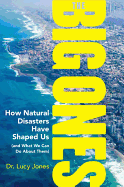
In the movies, natural disasters thrill us. Images of devastation shock us, and stories of survival in the midst of widespread death and destruction make us feel fortunate. But up close, natural disasters are terrifying. Survivors of earthquakes, hurricanes, volcanoes and other cataclysmic events often look for a reason why disaster struck, laying the blame on experts or others. But resilience can also emerge, making us more prepared for future catastrophes.
In The Big Ones, seismologist Lucy Jones surveys natural disasters throughout history. While most of us know that Mt. Vesuvius destroyed Pompeii in 79 A.D., Iceland's Laki eruption caused worldwide devastation in 1783, and the death of more than a million people. Unable to accept that disasters are "inexorably, infuriatingly random," blame gets assigned. Many viewed the All Saints' Day earthquake that destroyed Lisbon in 1755 as God's retribution. The Japanese blamed Koreans for the 1923 Kanto earthquake, leading to the slaughter of a third of Japan's Korean population in six days. Often, the consequences are far reaching. The Mississippi River flood of 1927 not only destroyed 26,000 square miles of land, it also forced African Americans to maintain failing levees and bear the brunt of the suffering; the underwhelming local response led to the federalization of disaster relief efforts.
Jones is a gifted storyteller, making complex geologic concepts accessible and having fun along the way (because, as Los Angelinos wait for The Big One, "sometimes, shift just happens.") And she provides hope that, when disaster strikes, communities will persevere. --Frank Brasile, librarian

